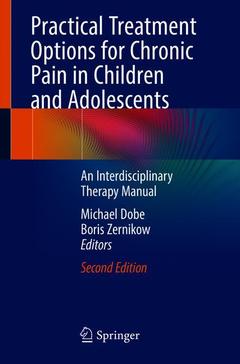Description
Practical Treatment Options for Chronic Pain in Children and Adolescents (2nd Ed., 2nd ed. 2019)
An Interdisciplinary Therapy Manual
Language: English
Subjects for Practical Treatment Options for Chronic Pain in Children...:
Support: Print on demand
Description
/li>Contents
/li>Biography
/li>Comment
/li>
Pain is an increasingly common symptom in children and adolescents. Once recurrent pain leads to pain-related disability that affects a child?s functional, emotional and social well-being, it is considered a chronic pain disorder. Such disorders can develop as the primary condition or be due to a well-defined underlying physical condition, such as migraine or juvenile idiopathic arthritis. Approximately 5% of the paediatric population suffers from a severe chronic pain disorder. Its treatment in childhood and adolescence is complex and needs to address a variety of biological, psychological and social influencing factors.
This treatment manual describes the inpatient treatment programme of one of the world?s largest inpatient treatment facilities for chronic pain management in children and adolescents ? the German Paediatric Pain Centre. The guidance provided is also applicable to outpatient pain management or day-hospital approaches.
The manual examines the epidemiology, aetiology, diagnostics and treatment principles in detail, explains the criteria for inpatient treatment, and describes the structure and organisation of a tertiary treatment centre for chronic pain. It also presents therapeutic interventions, such as dealing with ?Black Thoughts?, ?Distraction ABC?, ?Stress Day? and the ?Pain Provocation Technique? with the aid of numerous examples of pain management and health care from a clinical perspective.
Lastly, it discusses the special features of pain treatment for children and adolescents with comorbid psychological disorders, family difficulties or defined somatic diseases, as well as pharmacological and interventional treatment options.
Michael Dobe, Dipl.-Psych., is the leading psychologist at the German Paediatric Pain Centre at the Children’s and Adolescents’ Hospital Datteln, Germany.
Boris Zernikow is a German paediatrician who works in the field of pain therapy and palliative medicine. He holds the Chair of Children’s Pain Therapy and Paediatric Palliative Care at the Witten/Herdecke University and is Chief Physician at the Children’s and Adolescents’ Hospital Datteln, Germany.




